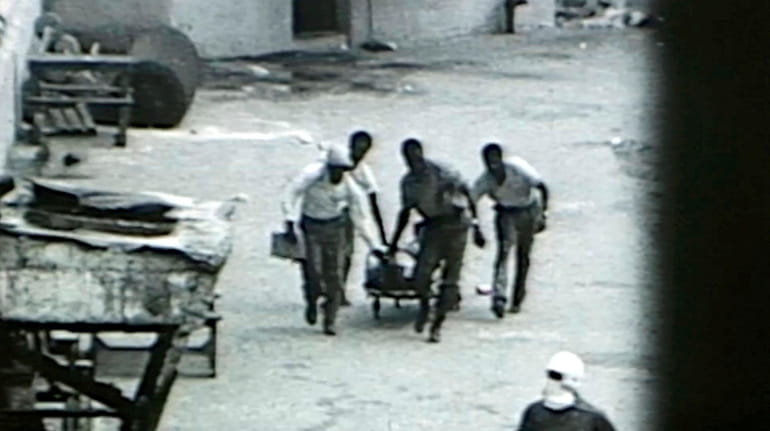'Attica' review: Powerful look at an event that still resonates

A still from "Attica," a documentay about the bloody 1971 prison uprising. Credit: SHOWTIME
DOCUMENTARY "Attica"
WHEN|WHERE Saturday at 9 p.m. on Showtime
WHAT IT'S ABOUT On Sept. 9, 1971, inmates protesting living conditions at Attica Correctional Facility west of Buffalo took over the prison and took 42 correction officers hostage. After four days of negotiations, Gov. Nelson Rockefeller ordered state police to retake the prison by force, killing dozens of hostages and prisoners in a hail of gunfire. This film, directed by Stanley Nelson (2016's "The Black Panthers: Vanguard of the Revolution") and Traci A. Curry, is based on interviews with inmates and family members who recall the five days that eventually led to the prisoners' rights movement.
MY SAY The last place most viewers want to visit this Saturday at 9 is Attica. Who can blame them? Nine minutes of carnage, 1,600 bullets, 29 dead inmates, 10 dead guards. Like old books and dusty LPs, the tragedy of Attica seems like ancient history that needs to be packed away. Let's move on. (We already have.) There are enough pressing problems in the world. This isn't one of them.
Or is it perhaps?
Filmmaker Nelson has made a career of fixing our gaze, however strong the impulse is to avert it. His most recent film, on the Tulsa race massacre of 1921, deployed the same techniques to accomplish this: Lots of historic footage threaded with interviews, and no narration. Let the facts and to an extent the ghosts speak for themselves. It's the same approach here.
His "Attica '' opens with testimony from a former prisoner ("Something was ready to happen at Attica…") followed by more inmate testimony, each word pushing the story forward. Some of our long-held assumptions — or prejudices — are quickly challenged. Deanne Quinn Miller, daughter of prison guard William Quinn, who was severely beaten in the opening minutes of the takeover, recalls how some prisoners placed him on a mattress, then carried him to where he could get medical attention. More testimony follows from white inmates. So this uprising wasn't strictly a race-based one? And while hated adversaries, did the families of prison guards and inmates find common cause at some point in the distant future?
Moreover, an inflection point seems to arrive early in the uprising when convicted cop killer and self-appointed jailhouse lawyer Jerry Rosenberg (who died in 2009) inspects a signed document from Rockefeller, which promises no reprisals if the inmates surrender. But when he doesn't see an official seal, Rosenberg decides it's nonbinding and tears it up for the rolling cameras. Cue to appointed Attica "observer" Herman Schwartz, now 89, professor of law emeritus at Washington University, who says that it was binding indeed.
In other words, the uprising could have ended right then and there?
After Quinn died a few days in, any hope of settlement passed. A seething racist rage gripped the state troopers outside the gates. While news media audio captures their words, the cameras will soon capture their actions. After the indiscriminate shooting has stopped, one exultant trooper yells "white power!" Another charges ABC reporter John Johnson who recalls saying, "'don't you dare…'"
In Nelson's telling, there was an inevitability to this massacre just as there was to the one in Tulsa fifty years earlier. History does have a way of fulfilling its own purposes, for better or ill.
But while comprehensive, something is still missing — the aftermath. A few title cards could have covered some subsequent events (inmates and families of the murdered prison guards did indeed sue the state for damages). Yet to cover them all would mean another hour of airtime. Like those old books and LPs, Attica is packed away and still with us. It just won't go away.
BOTTOM LINE Powerful ticktock (except the aftermath is missing). .
